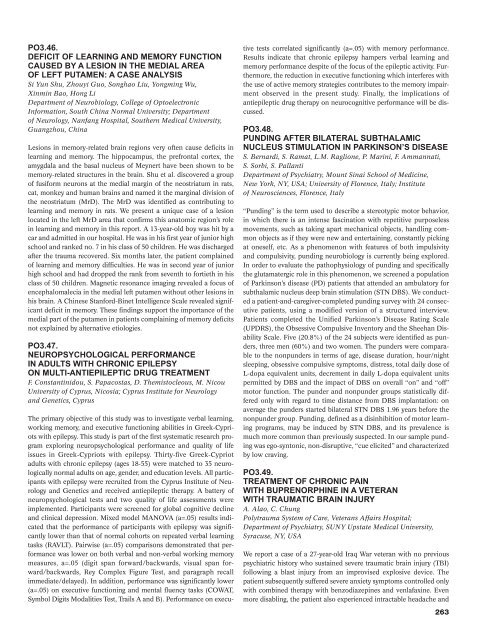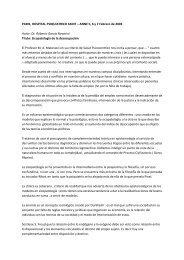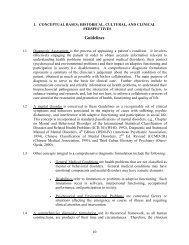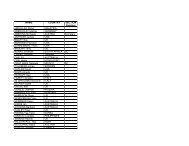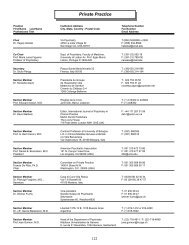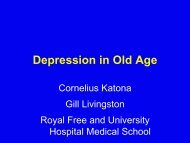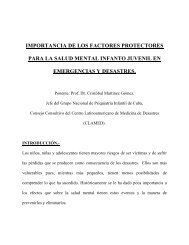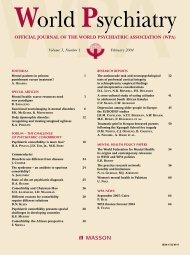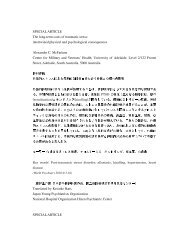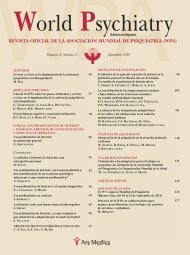ABSTRACTS - World Psychiatric Association
ABSTRACTS - World Psychiatric Association
ABSTRACTS - World Psychiatric Association
You also want an ePaper? Increase the reach of your titles
YUMPU automatically turns print PDFs into web optimized ePapers that Google loves.
PO3.46.<br />
DEFICIT OF LEARNING AND MEMORY FUNCTION<br />
CAUSED BY A LESION IN THE MEDIAL AREA<br />
OF LEFT PUTAMEN: A CASE ANALYSIS<br />
Si Yun Shu, Zhouyi Guo, Songhao Liu, Yongming Wu,<br />
Xinmin Bao, Hong Li<br />
Department of Neurobiology, College of Optoelectronic<br />
Information, South China Normal University; Department<br />
of Neurology, Nanfang Hospital, Southern Medical University,<br />
Guangzhou, China<br />
Lesions in memory-related brain regions very often cause deficits in<br />
learning and memory. The hippocampus, the prefrontal cortex, the<br />
amygdala and the basal nucleus of Meynert have been shown to be<br />
memory-related structures in the brain. Shu et al. discovered a group<br />
of fusiform neurons at the medial margin of the neostriatum in rats,<br />
cat, monkey and human brains and named it the marginal division of<br />
the neostriatum (MrD). The MrD was identified as contributing to<br />
learning and memory in rats. We present a unique case of a lesion<br />
located in the left MrD area that confirms this anatomic region’s role<br />
in learning and memory in this report. A 13-year-old boy was hit by a<br />
car and admitted in our hospital. He was in his first year of junior high<br />
school and ranked no. 7 in his class of 50 children. He was discharged<br />
after the trauma recovered. Six months later, the patient complained<br />
of learning and memory difficulties. He was in second year of junior<br />
high school and had dropped the rank from seventh to fortieth in his<br />
class of 50 children. Magnetic resonance imaging revealed a focus of<br />
encephalomalecia in the medial left putamen without other lesions in<br />
his brain. A Chinese Stanford-Binet Intelligence Scale revealed significant<br />
deficit in memory. These findings support the importance of the<br />
medial part of the putamen in patients complaining of memory deficits<br />
not explained by alternative etiologies.<br />
PO3.47.<br />
NEUROPSYCHOLOGICAL PERFORMANCE<br />
IN ADULTS WITH CHRONIC EPILEPSY<br />
ON MULTI-ANTIEPILEPTIC DRUG TREATMENT<br />
F. Constantinidou, S. Papacostas, D. Themistocleous, M. Nicou<br />
University of Cyprus, Nicosia; Cyprus Institute for Neurology<br />
and Genetics, Cyprus<br />
The primary objective of this study was to investigate verbal learning,<br />
working memory, and executive functioning abilities in Greek-Cypriots<br />
with epilepsy. This study is part of the first systematic research program<br />
exploring neuropsychological performance and quality of life<br />
issues in Greek-Cypriots with epilepsy. Thirty-five Greek-Cypriot<br />
adults with chronic epilepsy (ages 18-55) were matched to 35 neurologically<br />
normal adults on age, gender, and education levels. All participants<br />
with epilepsy were recruited from the Cyprus Institute of Neurology<br />
and Genetics and received antiepileptic therapy. A battery of<br />
neuropsychological tests and two quality of life assessments were<br />
implemented. Participants were screened for global cognitive decline<br />
and clinical depression. Mixed model MANOVA (a=.05) results indicated<br />
that the performance of participants with epilepsy was significantly<br />
lower than that of normal cohorts on repeated verbal learning<br />
tasks (RAVLT). Pairwise (a=.05) comparisons demonstrated that performance<br />
was lower on both verbal and non-verbal working memory<br />
measures, a=.05 (digit span forward/backwards, visual span forward/backwards,<br />
Rey Complex Figure Test, and paragraph recall<br />
immediate/delayed). In addition, performance was significantly lower<br />
(a=.05) on executive functioning and mental fluency tasks (COWAT,<br />
Symbol Digits Modalities Test, Trails A and B). Performance on executive<br />
tests correlated significantly (a=.05) with memory performance.<br />
Results indicate that chronic epilepsy hampers verbal learning and<br />
memory performance despite of the focus of the epileptic activity. Furthermore,<br />
the reduction in executive functioning which interferes with<br />
the use of active memory strategies contributes to the memory impairment<br />
observed in the present study. Finally, the implications of<br />
antiepileptic drug therapy on neurocognitive performance will be discussed.<br />
PO3.48.<br />
PUNDING AFTER BILATERAL SUBTHALAMIC<br />
NUCLEUS STIMULATION IN PARKINSON’S DISEASE<br />
S. Bernardi, S. Ramat, L.M. Raglione, P. Marini, F. Ammannati,<br />
S. Sorbi, S. Pallanti<br />
Department of Psychiatry, Mount Sinai School of Medicine,<br />
New York, NY, USA; University of Florence, Italy; Institute<br />
of Neurosciences, Florence, Italy<br />
“Punding” is the term used to describe a stereotypic motor behavior,<br />
in which there is an intense fascination with repetitive purposeless<br />
movements, such as taking apart mechanical objects, handling common<br />
objects as if they were new and entertaining, constantly picking<br />
at oneself, etc. As a phenomenon with features of both impulsivity<br />
and compulsivity, punding neurobiology is currently being explored.<br />
In order to evaluate the pathophysiology of punding and specifically<br />
the glutamatergic role in this phenomenon, we screened a population<br />
of Parkinson’s disease (PD) patients that attended an ambulatory for<br />
subthalamic nucleus deep brain stimulation (STN DBS). We conducted<br />
a patient-and-caregiver-completed punding survey with 24 consecutive<br />
patients, using a modified version of a structured interview.<br />
Patients completed the Unified Parkinson’s Disease Rating Scale<br />
(UPDRS), the Obsessive Compulsive Inventory and the Sheehan Disability<br />
Scale. Five (20.8%) of the 24 subjects were identified as punders,<br />
three men (60%) and two women. The punders were comparable<br />
to the nonpunders in terms of age, disease duration, hour/night<br />
sleeping, obsessive compulsive symptoms, distress, total daily dose of<br />
L-dopa equivalent units, decrement in daily L-dopa equivalent units<br />
permitted by DBS and the impact of DBS on overall “on” and “off”<br />
motor function. The punder and nonpunder groups statistically differed<br />
only with regard to time distance from DBS implantation: on<br />
average the punders started bilateral STN DBS 1.96 years before the<br />
nonpunder group. Punding, defined as a disinhibition of motor learning<br />
programs, may be induced by STN DBS, and its prevalence is<br />
much more common than previously suspected. In our sample punding<br />
was ego-syntonic, non-disruptive, “cue elicited” and characterized<br />
by low craving.<br />
PO3.49.<br />
TREATMENT OF CHRONIC PAIN<br />
WITH BUPRENORPHINE IN A VETERAN<br />
WITH TRAUMATIC BRAIN INJURY<br />
A. Alao, C. Chung<br />
Polytrauma System of Care, Veterans Affairs Hospital;<br />
Department of Psychiatry, SUNY Upstate Medical University,<br />
Syracuse, NY, USA<br />
We report a case of a 27-year-old Iraq War veteran with no previous<br />
psychiatric history who sustained severe traumatic brain injury (TBI)<br />
following a blast injury from an improvised explosive device. The<br />
patient subsequently suffered severe anxiety symptoms controlled only<br />
with combined therapy with benzodiazepines and venlafaxine. Even<br />
more disabling, the patient also experienced intractable headache and<br />
263


